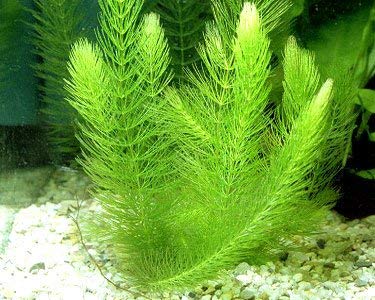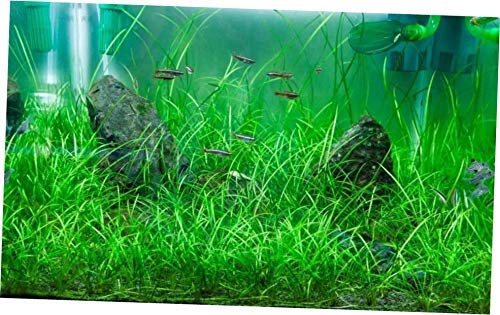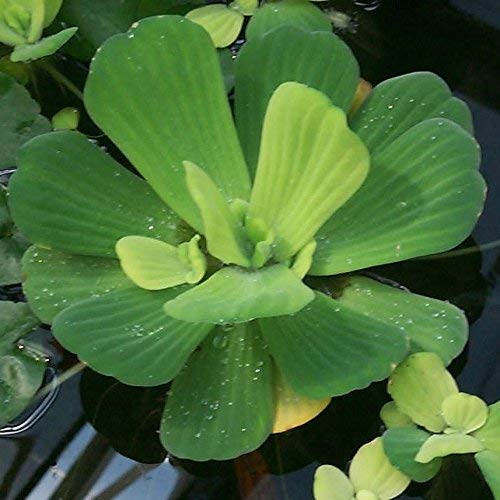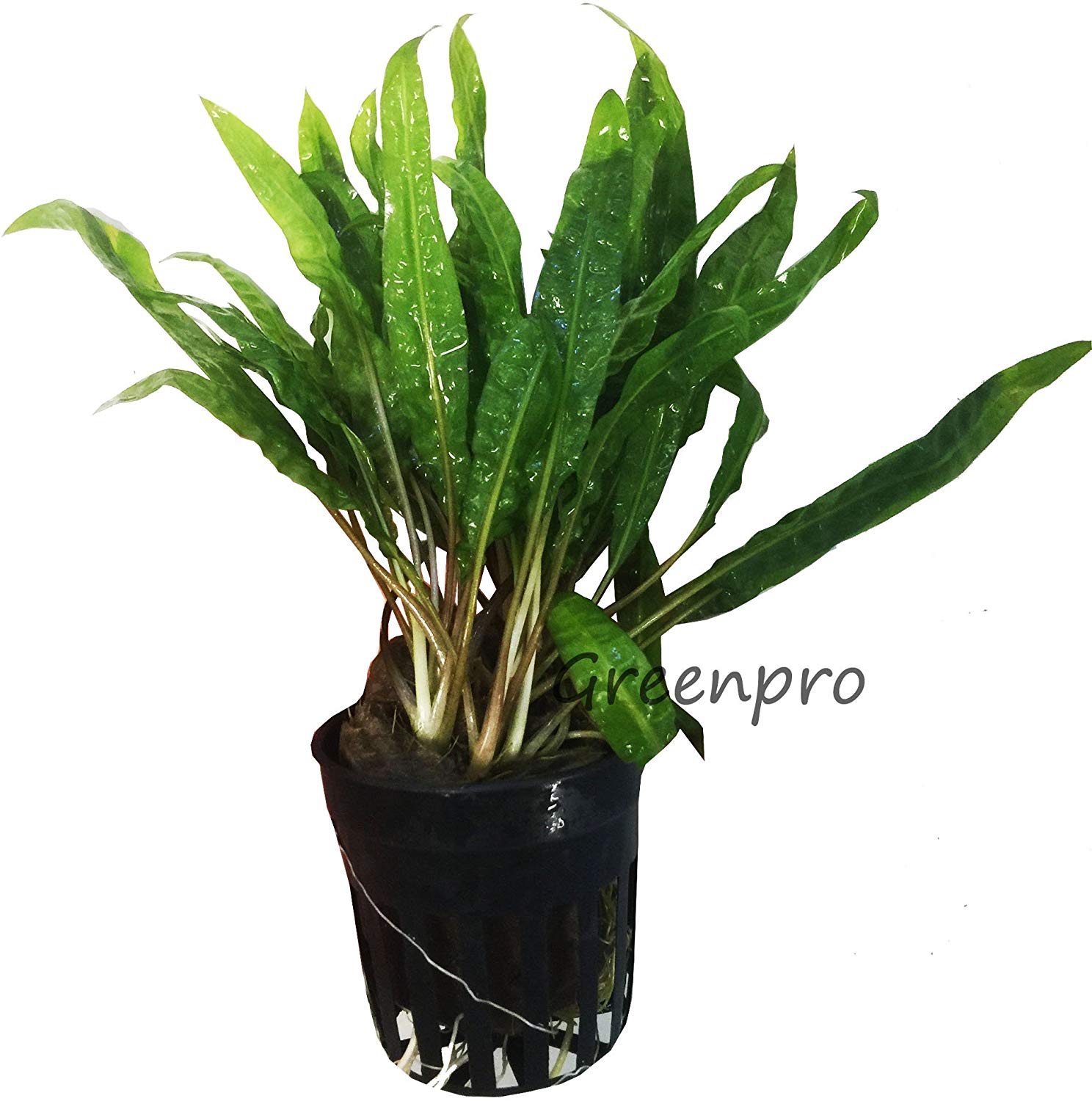Best Freshwater Plants for Your Aquarium
As pretty as fish and shrimp are, you have to keep them healthy to see them in all their glory in an aquarium. Like shrimp, aquariums come in all sizes and how much you might end up paying for one is as long as a piece of string. The last thing you are looking for is a fancy bowl of dead water so that's why finding the best aquarium plants is so very important. The right kind of aquatic plants are the ones that replicate natural habitat and add to an ecosystem. In return, you get an aquarium that’s healthy and bustling with activity.
Here are some of the best plants for aquarium to buy:
The Best Aquarium Plants: Our Top Picks
1. Hornwort
In case you're looking for a good background plant for your fish, hornwort is surely a great option to consider. It is among the best aquarium plants that can grow rotted in the substrate or floating in the water.
Another good reason to buy it is that it grows quite quickly. In fact, it may be a negative thing for many, as it can sometimes take over the rest of the decorations you have in your aquarium. Making the right selection of supplies will surely make a difference here. Nevertheless, the plant is quite hard and requires little care to grow properly, which is a great thing for someone not willing to do all the maintenance.
As the plant grows quite thick, it provides a reasonably dense area for your fish to hide and play. Another interesting thing is that the plan sheds its leaves, which can be used as food for some varieties of fish. Moreover, it also looks quite stylish and aesthetically pleasing with its dark green color.
Overall, it's a wonderful choice for beginners because this is a hard aquarium plant, but be ready to deal with it when it grows a bit too quickly.
PROS
CONS
2. Pygmy Chain Sword
If you're in search of a plant that would serve great as the foreground of your fish tank, you may want to try Pygmy Chain Sword. It requires moderate care, and if everything goes fine, you will soon after a pretty carpet of light green in your fish tank.
You don't need to worry too much about temperature with this aquarium plant, as it works just perfectly in temperatures from 65-80 degrees. You don’t need to worry much about its health, so long as it's rooted in aquarium substrate, as that's how it takes all the nutrients it needs to thrive.
It is a good idea to divide the roots when the plant is still young and not turned into an adult plant, as it will help it propagate better across the bottom of your fish tank. Another good thing is that the plant produce seeds, which means you can use it to cultivate new plants whenever you want.
Overall, it's a great choice for any aquarium lover, but an important thing to keep in mind is that though the plant can easily grow up to 6 inches, you may not find it suitable for a very large aquarium.
PROS
CONS
3. Water Lettuce
This green plant from the Araceae Family can make your fish tank look perfect. It is an extremely popular option for anyone looking for aquarium plants. It is a hardy plant and doesn't need a lot of attention to thrive. You can create a great ambiance using it in your coldwater aquarium, but it looks as impressive in ponds. It means that you can still use it for your tropical aquarium, but it may not be the ideal choice.
You can keep it in a home aquarium with ease, but keep in mind that it may not achieve its maximum height of 10 inches in that case. It grows floating the water surface, but its leaves create a stunning look by forming a rosette, with submerged roots underneath. It is quite suitable for most fish, but you may notice larger fish developing the habit of eating the roots, which can damage the plant.
You can order it easily through Amazon, but do keep in mind that Water Lettuce is a live plant and can suffer a great deal due to high temperatures. Therefore, you may want to avoid ordering one when the temperature is expected to go up to 100F.
PROS
CONS
4. Cryptocoryne Balansae
If you're searching for a stunning plant for a contrasting element in your aquarium tanks, you can get great results by using cryptocoryne blansae. It also serves great as a foreground of your tank.
Originally from Southern Thailand, this plant with high limestone content can thrive in your aquarium if it is rich in phosphate, nitrate, CO2, iron, and calcium. For this, you will have to use fertilizers.
Keep in mind that you will have to pay a little attention to lighting and water conditions. With correct lighting, the plant will get its green coloration, whereas the correct water conditions will help it flower.
The good thing about the plant is that you can easily use it in submerged aquariums. It is equally suitable for plant displays and vivariums, mainly because it doesn’t need to be submerged in water to thrive.
Interestingly, the leaves will get less ruffled and more rounded when you grow it on dry land.
PROS
CONS
FAQ - A Buyer's Guide
What are the Easiest Aquarium Plants to Grow?
If you're looking for the plants that won't require a lot of attention and grow quite easily too, you should consider picking one from the following list.
The Amazon Sword
Amazon swords receive almost all of their minerals and nutrients from soil substrates so they are perfect for keeping a tank clean. They are tap root plants so a substrate is required at the time of planting. Although they are cultivated out of water, the foliage can disintegrate when first introduced to a tank. It’s usual, and the Amazon sword quickly regrows. For best results, add extra nutrients by using a root tab periodically. With its large sword-like leaves, it looks stunning and grows quickly when the water temperature is around 72-82F. Medium lighting is required for optimal growth. You can use the Amazon Sword for hiding plumbing, creating protection, and enhancing decoration.
Vallisneria
Vallisneria eel grass can grow up to 6 feet in length if given the opportunity. Vallisneria receives its nutrients from the substratum as well as the water column. This means it's essential to fertilize the water column with liquid fertilizers and also use root tabs for nutritional substratum.
Vallisneria takes time to settle in, but it will start to spread quickly after about six weeks and can easily create a jungle-type look in your tank.
Pogostemon stellatus octopus
If left to grow, pogostemon stellatus octopus will take over. It’s fine leaves make great hiding spots for fry and timid fish. This plant benefits more from fertilizer in the water column but even root tabs will make a difference.
Dwarf Baby Tears
If you're looking for an easy-to-grow carpeting plant for your fish tank, you can go for Dwarf Baby Tears. The plant is extremely tough and hard working at the same time. You can use it in a variety of aquascaping styles, and it looks stunning when it's producing oxygen, which will create little bubbles on its leaves. The plant is capable of tolerating temperatures around 72-85 F, but it grows best when the temperature is around 73-75F. Similarly, you will notice it grow properly in bright lighting condition. You can use it for substrate covering, decoration, protection, as well as carpeting.
Cryptocoryne
Another fantastic and simple aquarium plant is the cryptocorynes or crypts. Like Amazon sword, crypts usually melt when first added to an aquarium but bounce back quickly once they adapt to the water quality. Crypts are very resilient and an amazing foreground or midground plant.
Anubias
Anubias are last on the list, but along with crypts, they're one of the best for an aquarium. Anubias are slow growers, hardy and adaptive. Anubias are wonderful low-light plants and will flourish even without fertilizers.
Dwarf Hairgrass
You can't go wrong with this freshwater aquarium plant because it provides you with amazing opportunities for aquascaping. Its contrasting appearance with dark soil or sand makes it look amazing. It also looks great when you keep it close to Stone. Again, it is one of the easiest growing plants; in fact, it grows so quickly that you might have to spend some time trimming it. It can tolerate most environment but grows perfectly when the water temperature is around 72-78F. You can use it for decoration as well as for accenting hardscape features, such as wood and stone.
What Plants are Good for Aquarium?
Depending on the environment you want to create in your aquarium, your choice for plants in aquarium will change considerably. Many aqua plants are easy to grow, require little maintenance, and help achieve the best results in an aquarium. If you're confused, you can always consider putting your money on the following aquarium plants.
Java Moss
This plant is very popular in freshwater tanks and a favorite of shrimp enthusiasts because of the cover it creates. Java moss grows well and is useful as a filler around rocks. You will need to secure them with elastic bands until they root in. This plant is notorious for floating but with care you train it to grow upwards and out of the tank.
Java Fern
Like Java moss, the Java fern is among the best freshwater aquarium plants and flourishes in low light conditions. They anchor their roots systems around stones and rocks. Once established the Java fern is low maintenance and seldom needs fertilizers making it perfect for beginners. It is also relatively cheap to buy.
Water Wisteria
This aquatic plant Hygrophila difformis is also called bunch plant and is a staple amongst shrimp-keeping aquarist. It branches out spreading lace-like leaves throughout the aquarium creating the ideal shrimp habitat. It is undemanding, hardy and simple to propagate. All you need to do is cut out a thick, stable base then bury it gravel at 3 to 4 inches deep and the plant continues the germination process.
Do Live Plants Help Aquariums?
Finding and using the best aquarium plant is essential, especially for your freshwater aquarium. Whether you're a beginner or you've been maintaining an aquarium for some time, you will always benefit a great deal by choosing the right live aquarium plants. Here are some reasons why going for a live aquarium plant makes great sense.
Aquatic plants provide sanctuary for fish and fry
Certain fish species are aggressive and others are naturally shy and timid. Hardscape and aquatic plants create hideaways and safe places. Having plants around as cover also triggers breeding cycles and provides security and protection for eggs and fry.
Aquatic plants reduce algae
Aquatic plants compete for the same essential nutrients as the algae. These nutrients, iron, nitrates, potassium and many trace elements, are essential for all plant growth. A sufficient number of stem aquatic plants will effectively starve out the algae although slower growing plants like Anubias may have trouble competing.
Live plants remove carbon dioxide and add oxygen
In an aquarium, aquatic plants oxygenate the environment. They ingest waste carbon dioxide and release oxygen. Airstones and pumps help too since there needs to be plenty of oxygen available for the entire aquarium ecosystem to benefit and be healthy.
Why My Aquarium Plants are Dying?
There are so many reasons why your aquarium plants may start to die. Here are some of the warning signs suggesting that something is wrong and that you should take an action. If you can spot the signs and know the underlying cause, there's always time to try a solution and bring your aquarium plant back to life.
Yellowing leaves
One potential cause of yellowing leaves is poor light. Try adding a full spectrum bulb that provides 3 to 5 watts of light per gallon of tank volume. If only the edges of leaves are yellowing you need to add a fertiliser to counter a possible potassium deficiency.
Brown and black patches
Aquarium plants benefit from nutrient supplements and regular use prevents issues such as brown or black leaves. Potassium, phosphorus and nitrogen are the most essential but supplements also contain vital trace elements. A deficiency in any will cause the plant cells to breakdown, turn brown and die.
Holes
Most likely holes in the leaves are cryptocoryne rot. Often, surplus nitrate is a factor but the trigger is still a bit of a mystery. Poor water quality and nutrient insufficiency are also cited. With few real clues, the only way to rectify the issue is with a big water change and a thorough gravel clean.
Brittle leaves
Brittle leaves are probably the result of iron deficiency although it could be potassium or excessively high pH. Consider fertilizing your substratum with an iron-rich fertilizer. It will also help to reduce the carbonate hardness of the water.
The Best Aquarium Plant for You to Buy
Your aim is to create a sustainable environment that requires as little human intervention as possible. Plants are an essential part of any stable environment. They recycle the waste and help manage the habitat. They are also a good indicator of the overall health of your entire tank. It’s a bonus that so many are stunningly beautiful. A well-planted aquarium is not only a talking point, but it also means happy reproductive fish and shrimp. If you're confused which one to buy, try Pygmy Chain Sword, especially if you're looking for an accent plant.
About the Author Steven
Related Posts
Is It More Cost Effective To Build Your Own Aquarium?
5 Best Tips for Training Your Service Dog
DOT Announces Upcoming Changes for ESAs and Plane Travel
Best Cleaning Tips for Your Aquarium
Best Waterless Shampoos for Your Dog
Best Muzzles for Your Pit Bulls





